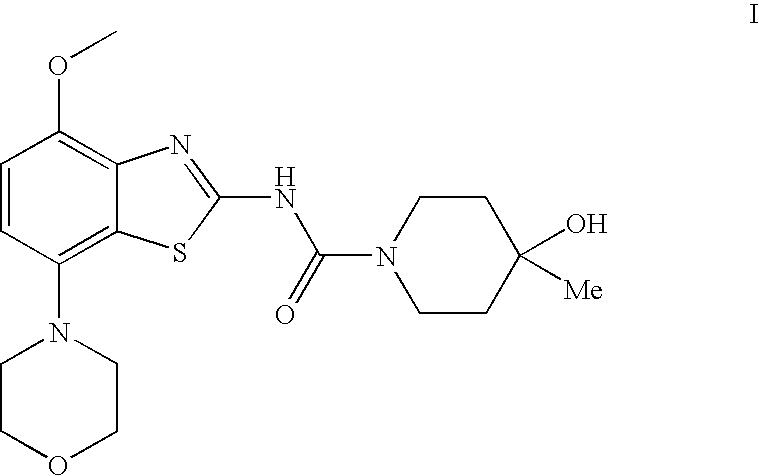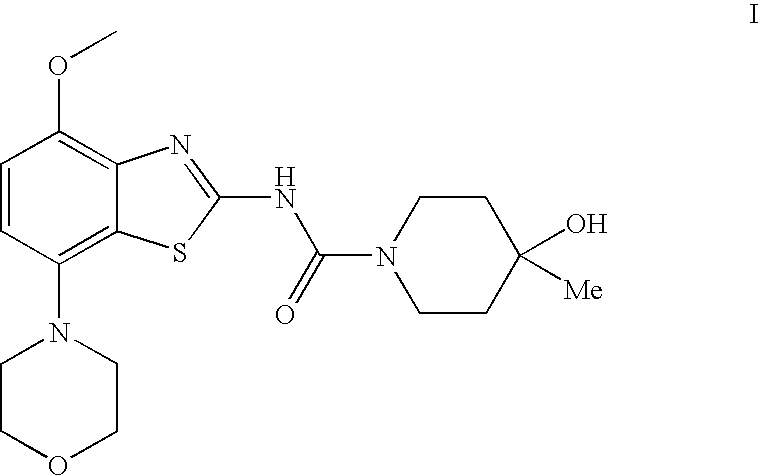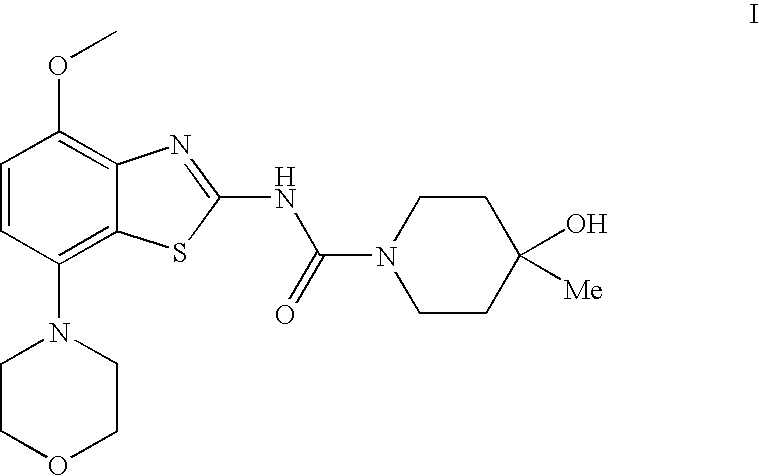4-Hydroxy-4-methyl-piperidine-1-carboxylic acid (4-methoxy-7-morpholin-4-yl-benzothiazol-2-yl)-amide
a technology of methylpiperidine and methylpiperidine, which is applied in the field of 4hydroxy-4-methylpiperidine-1-carboxylic acid (4methoxy-7-morpholin-4-ylbenzothiazol-2-yl)amide, can solve the problems of brain damage or death of individuals, and achieve the effect of potent and long-acting in vivo oral antagonism of adenosine a2a receptor-induced behavior and high affinity
- Summary
- Abstract
- Description
- Claims
- Application Information
AI Technical Summary
Benefits of technology
Problems solved by technology
Method used
Image
Examples
example 1
4-Hydroxy-4-methyl-piperidine-1-carboxylic acid(4-methoxy-7-morpholin-4-yl-benzothiazol-2-yl)-amide (I)
[0065] To a solution of (4-methoxy-7-morpholin-4-yl-benzothiazol-2-yl)-carbamic acid phenyl ester (3.2 g, 8.3 mmol) and N-ethyl-diisopropyl-amine (4.4 ml, 25 mmol) in trichloromethane (50 ml) is added a solution of 4-hydroxy-4-methyl-piperidine in trichloromethane (3 ml) and tetrahydrofurane (3 ml) and the resulting mixture heated to reflux for 1 h. The reaction mixture is then cooled to ambient temperature and extracted with saturated aqueous sodium carbonate (15 ml) and water (2×5 ml). Final drying with magnesium sulphate and evaporation of the solvent and recrystallization from ethanol afforded the title compound as white crystals (78% yield), mp 236° C. MS: m / e=407(M+H+).
example 2
(4-Methoxy-7-morpholin-4-yl-benzothiazol-2-yl)-carbamic acid phenyl ester (IV)
[0066] A suspension of 4-methoxy-7-morpholin-4-yl-benzothiazol-2-ylamine (26.5 g, 100 mmol) in dichloromethane (56 ml) and pyridine (56 ml, 700 mmol) is added phenyl chloroformate (15.7 ml, 125 mmol) at 0-5° C. and the reaction mixture is warmed to ambient temperature. After 1 h, water (7.2 ml, 400 mmol) was added and the reaction mixture is heated for 1 h to 45° C. Then ethyl acetate (250 ml) and 2M HCL (125 ml) were added and the organic phase separated. After removal of the solvent and recrystallization from tert.butyl-methyl ether and finally from ethanol the title compound was obtained as white solid (80% yield), mp 166-168° C. MS: m / e=386(M+H+).
example 3
4-Methoxy-7-morpholin-4-yl-benzothiazol-2-yl-amine (II)
[0067] (2-Methoxy-5-morpholin-4-yl-phenyl)-thiourea (5.0 g, 19 mmol) in chloroform (130 ml) are treated with bromine (960 μl) and the mixture refluxed for 18 hours. After removal of the volatile components in vacuo, the product is recrystallized from THF (2.8 g, 57%). MS: m / e=266 (M+).
PUM
| Property | Measurement | Unit |
|---|---|---|
| Disorder | aaaaa | aaaaa |
Abstract
Description
Claims
Application Information
 Login to View More
Login to View More - R&D
- Intellectual Property
- Life Sciences
- Materials
- Tech Scout
- Unparalleled Data Quality
- Higher Quality Content
- 60% Fewer Hallucinations
Browse by: Latest US Patents, China's latest patents, Technical Efficacy Thesaurus, Application Domain, Technology Topic, Popular Technical Reports.
© 2025 PatSnap. All rights reserved.Legal|Privacy policy|Modern Slavery Act Transparency Statement|Sitemap|About US| Contact US: help@patsnap.com



